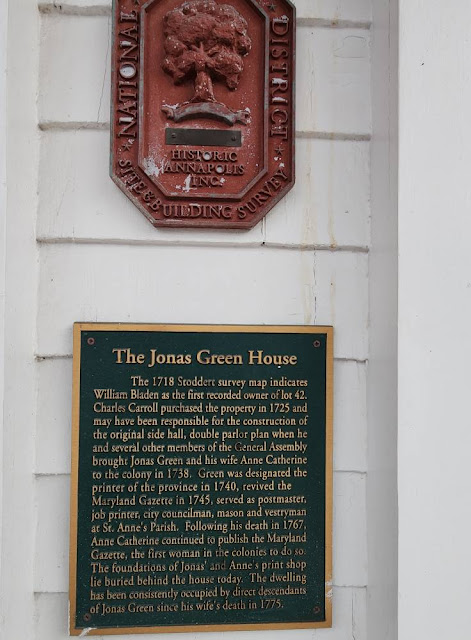It's always hard to say goodbye. The time has come to bid Adieu to Anne Catherine Hoof Green of Annapolis. Died March 23, 1775. Mrs. Green has been one of our most beloved local women and you can find out more about her at the links below. The local living historian who has portrayed Mrs. Green for about 15 years is retiring so it was only appropriate to send her off in the style that a woman of her stature deserves.
A walking tour of sites that were important to the Green family. The tour started at State Circle across the street from the Maryland State House, which is the oldest continually operating state house in the country.
Old Post Office in Historic Annapolis
From there, the tour progressed to the Jonas Green House which is under private ownership. The family was so gracious in letting us use their home. Two of Mrs. Green's sons were mourning in the first parlor where her obituary was read. Then visitors progressed to the dining room where we had a few displays. I made a presentation about mourning dress and funeral traditions in the 18th century. Some resources are listed below.
The Green House
From my presentation notes (Blogger isn't letting me cut and paste):
Interesting article about a more simplefuneral procession:
Newport Mercury 10-1-1764
Other ads about mourning materials being sold:
Maryland Gazette 6-14-1764
Providence Gazette 6-6-1764
New York Mercury 5-18-1767
This one is a particular favorite in that it advertises hair plaiting for mourning jewelry. We typically see plaited hair jewelry in the early 19th century though there is a piece that belonged to the Handcock family from the 1790s in the Massachusetts Historical Society.
Extant baker's wrapper dated 1828
I ended up making funeral biscuits for the participants to snack on:
Other photos from the house:
Parlor with casket
Local minister and Mrs. Green's sons
Some items printed by Jonas and Ann
Mourning gloves and mitts
Mourning Jewelry
Me with my display
From the house, we proceeded to St. Annes where we learned about burial traditions, who prepared the body and how it was prepared. The Greens are buried at St. Anne's in unmarked graves.
St. Annes
Our last stop was The Reynolds Tavern across the street. The tavern was founded in 1747. We had a toast to Mrs. Green. The tavern prepares a punch based on the familiar 18th century recipes.
Punch at the Reynolds Tavern
I had so much fun doing this event. I've always been fascinated by funeral/mourning customs so this really enabled me to delve into the subject and to show off some of my collection of mourning accessories. It was also a nice way to say goodbye to Diane in her portrayal of Mrs. Green.
I would encourage you to read the first article in my resource list that profiles her life.
Memento Mori by William Michael Harnett
Resources:
Books
In Death Lamented: The History of Anglo-American Mourning Jewelry
Mourning Dress: A Costume and Social History
Articles
Ann Catherine Hoof Green--Maryland Archives
The Handsome Tokens of a Funeral: Glove-Giving and the Large Funeral in Eighteenth-Century New England
"Often concerned in funerals:" Ritual, Material Culture, and the Large Funeral in the Age of Samuel Sewall--Colonial Society of Massachusetts
The Era of Excessive Mourning
The Colour of Mourning--All Things Georgian
Momentos Mori: The Materials of Mourning--Colonial America 1607 - 1763
Colonial New England Funerals
The Lowest Ebb of Misery: Death and Mourning in the Family of George Washington
English Funeral Food
Recipe for Funeral Biscuits
Virginia Gazette March 1, 1737
Other primary accounts from Maryland State Archives




























Fantastic read; your black dress and mourning accessories are sublime. Anna in SW Virginia
ReplyDelete